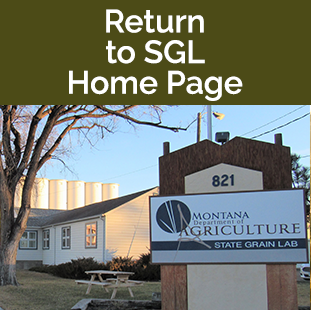Sampling Procedures
Accurate Bin and Truck Sampling
Very few fields of grain in Montana are totally level or uniform in quality. Lower areas have more subsoil moisture, higher bushel per acre yields and lower protein. Higher areas have less moisture, fewer bushels per acre and higher protein. Frost settles in low areas in a field resulting in non-uniform percentages of frost damage. Moisture creates higher percentages of sprout damage on the portion of a field that is the most mature. These conditions result in very few bins being totally uniform in quality.
It is extremely difficult to accurately sample a bin after it has been filled. Sampling a full bin with a sectioned or standard tier probe leaves large areas of the bin unsampled. This results in grade, dockage and/or protein results that often do not match results on delivered grain.
It is in the producer's and the elevator's best interest to negotiate grain sales based on accurate bin sample results. Producers and elevators both dislike the problems resulting from a difference in bin sample and unload results.
The most accurate way to sample a truck is with a compartmentalized tier probe. Realizing this is impractical during harvest or in most elevator settings, following are some practical suggestions for accurately sampling a bin or truck.
- Pre-harvest planning, a five-gallon plastic bucket numbered for each bin or composite sample and a sampling device.
- Use an odor free sampling device to collect samples (scoop, can or cup)
- Sample each truck load according to size so the sample will represent the bin or lot of grain.
- A cut of the stream for every 100 bushels. Example: A 300-bushel truck three cuts, a 500-bushel truck five cuts or a 1,000 bushel truck 10 cuts. This will weight the sample by volume to represent the bin or lot of grain.
- The sampling device should be quickly drawn across the stream of grain from one side to the other without completely filling the device.
- As protein and quality can vary considerably in a bin or lot of grain, the sample should be thoroughly mixed.
- Hand mixing of a bin or composite sample does not achieve consistent accurate results. The most efficient way of mixing a sample is to utilize a divider/mixer. As most producers or elevators do not have access to a divider/mixer, the following methods work well.
- Place the bin sample on a tarp and thoroughly mix with a garden hoe.
- Pour the elevator composite sample from one container to another, approximately 10 times.
Suggestions for Sampling Bins
Section Probe
Probe grain at the inspection cover and if possible at the center of the bin adding sections until the probe has been pushed into the grain as far as possible or the bottom of the bin is reached. If it is only possible to sample at the inspection cover probe in different directions to acquire grain from different locations in the bin.
Tier Probe
Probe grain at the inspection cover and if possible at the center of the bin. Also take one probe through the augur hole to draw a portion of the sample from the bottom of the bin. If it is only possible to sample at the inspection cover probe in different directions to acquire grain from different locations in the bin.
Hand mixing of a bin sample does not achieve consistent accurate results. The most efficient way to mix a sample is to use a divider/mixer. As most producers do not have access to a divider/mixer the following methods work well.
- Place the bin sample on a tarp and thoroughly mix with a garden hoe.
- Pour the bin sample from one container to another at least ten times.
If producers do not have access to a sectioned or a tier probe they can usually borrow one from their local elevator. The State Grain Laboratory is available to assist any producer with advise or information on bin sampling. If producers are located close enough to the State Lab, we would be willing to loan you a probe to use for sampling your bins.

